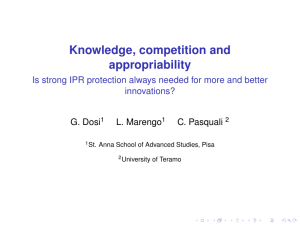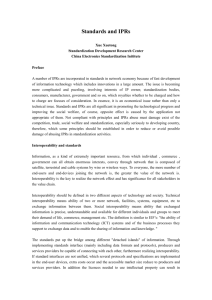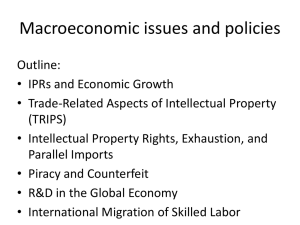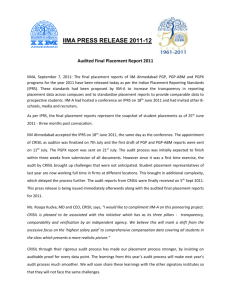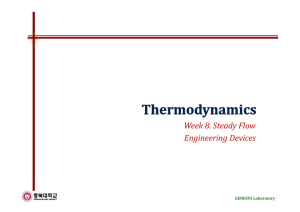Recent enforcement practice under the R&D&I Framework
advertisement
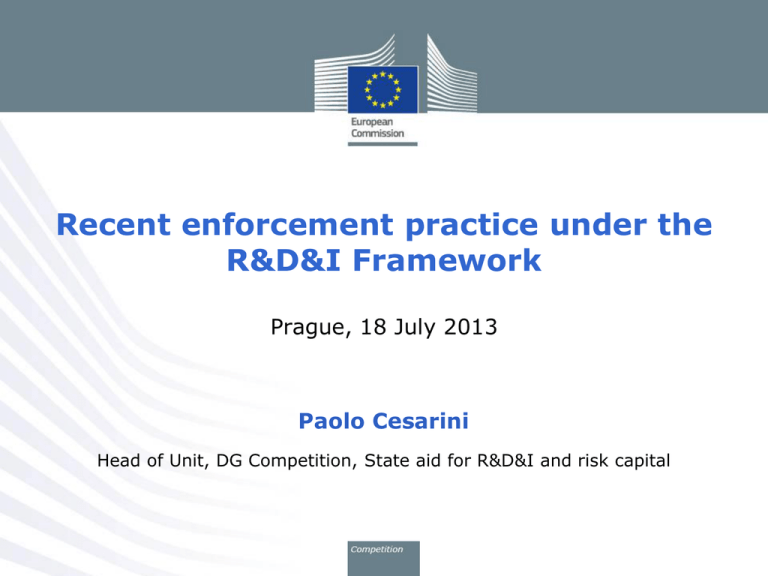
Recent enforcement practice under the R&D&I Framework Prague, 18 July 2013 Paolo Cesarini Head of Unit, DG Competition, State aid for R&D&I and risk capital Some key issues from recent case practice • The on-going discussions on the revision of the R&D&I Framework have raised, amongst others, the following key issues Assessment of State funded research infrastructures Aid to pilot lines and prototypes involving subsequent commercial use Allocation of IPRs within collaborative research projects and distinction of economic and non-economic activities Appropriateness of aid instruments and minimisation of aid for close-tomarket projects • Four cases will illustrate the Commission’s approach to these issues The Green Labs/DK case (2011) The Wave Energy Demonstration Plant/SW case (2011) The Genesys/FR case (2013) The Diehl Aircabin/DE case (2009) 1. Research infrastructures: the Green Lab case (2011) • Objective and design of the scheme. Promoting innovation for climate, environment and energy efficient technologies through the establishment of testing and demonstration facilities (Green Labs) Targeted mainly at SMEs affected by coordination and sub-critical mass problems hindering the set up of independent facilities Grants awarded to Green Labs selected via open calls and on the basis of transparent, non-discriminatory criteria Open-access facilities for rent to users at market prices, without prejudice to a discount applicable during a specified period o 100% economic use 50% private financing Private investors do not enjoy lower access prices but preferential access conditions within strict limits (limited period and maximum capacity utilisation) 1. Research infrastructures: the Green Lab case (2011) • Compatibility grounds construed on current R&D&I rules Currently no specific legal basis for assessing compatibility of research infrastructures carrying out non-ancillary economic activities The Danish government conceived a complex construction by designing the aid measure under two separate aid categories: o Aid to innovation clusters => investment aid to Green Labs o Aid for innovation advisory and support services => pass-on to infrastructure users Possibility of de minimis aid at users' level, notably for large undertakings 2. Pilot lines and demonstrators: the Wave Energy Demonstration Plant case (2011) Project characteristics • System of 420 wave energy converters (WEC) with varying power output • Transformation of the electricity to alternating current suitable for transmission • Development of two submarine electrical systems: • • Low voltage marine substation (LVMS) Medium voltage marine substation (MVMS) • Connection to grid and testing 2. Pilot lines and demonstrators: the Wave Energy Demonstration Plant case (2011) • Design of the aid measure Project financing: contributions by Seabased (a spin-off of Upsala university), Fortun (a Swedish electricity producer and distributor) and an ad hoc grant to Seabased by Sweden Grant: 43% of Seabased R&D eligible costs Advantage for Seabased: ownership of patents possibly resulting from successful experimental development of the pilot plant Transfer of ownership of the pilot plant to Fortun for connection to the grid and further testing of plant properties Negative NPV: project with aid well below Fortun’s profitability rate, even taking into account possible revenues from future electricity sales If NPV > 0 Fortun will repay the corresponding amounts with interest Safeguard: any subsequent commercial use of the prototype will be monitored to ensure claw-back of revenues beyond break-even point 2. Pilot lines and demonstrators: the Wave Energy Demonstration Plant case (2011) • Assessment Positive effects and proportionality of the aid o Market failure: bank financing unavailable absent demonstration of wave energy technology; strong positive externalities o Incentive effect: « no-project » as conterfactual scenario; profitability for Seabased occurring only potentially from future applications; negative NPV and slightly positive IRR for Fortun in a scenario with aid o Proportionality: aid below maximum aid intensities coupled with claw-back mecanism Limited market distortions o Market definition o Undistorted dynamic incentives o No market power 3. Allocation of IPRs within PPPs: the Genesys case (2013) • Objective and design of the aid measure R&D to develop 3rd generation bio-refineries (based on ligno-cellulose biomass) for several downstream sectors (energy, food, chemicals) Grant and capital injection in a start-up (Pivert) set up to manage fundamental and industrial research (articulated in clearly defined subprograms) within a 50%/50% Public/Private Partnership (PPP): o Public actors: 3 universities and a consortium of 14 research organizations o Private actors: 6 industrial partners o Genesys project coming within the R&D programs of the ROs concerned Investment in open-access facilities (Biogis Center) Expected outcome: o pool of 40 (enabling) patents in 10 years co-owned by the public actors o licensing at market terms by Pivert o knowledge dissemination through about 100 publications per year 3. Allocation of IPRs within PPPs: the Genesys case (2013) Subvention R&D 50% 50% 3. Allocation of IPRs within PPPs: the Genesys case (2013) • Assessment under the R&D&I Framework Necessary and proportionate aid to Pivert (beneficiary) o o o "external" technology licensing as economic activity Proof of market failure and incentive effect Aid kept to a minimum No aid to Academic members: revenues from Pivert licensing activities allocated amongst members in line with their contributions and re-invested in public independent research No aid to Industrial members: o o o o o Open access to Industrial Club by interested competitors IPRs' ownership allocated to public partners (Academic members) IPRs' management entrusted with the start-up (Pivert) IPRs' access by Industrial Club members (on exclusive or non-exclusive basis) at market conditions Possibility for outsiders to compete for IPR licenses 4. Revolving instruments for close-to-market innovation: the Diehl Aircabin case (2009) • Objective of the aid measure Supporting two distinct R&D projects for the development of systemic components by a tier 1 Airbus supplier (DA) o Product specifications fixed by Airbus o DA selected by Airbus through a competitive process Technological challenge: integration of advanced materials for weight reduction and fuel efficiency Market failure mainly in the form of asymmetry of information o High technical and commercial risks and long-term credit periods o Presence of risk-sharing partners but profitability gap deterring bank lending 4. Revolving instruments for close-to-market innovation: the Diehl Aircabin case (2009) • Design of the aid measure Aid awarded under the German "Aircraft Supplier Scheme" Eligible costs falling entirely under experimental development Two aid instruments o A state aid-free loan (8% of eligible costs) o A (25% of eligible costs) o repayable advance Appropriate reimbursement conditions, interest rate and royalty beyond full repayment for the repayable advance "Successful outcome" as a condition for repayment Risk mitigation and profitability levels of the project based on different scenarios of future A 350WXB sales (determined through independent expertise). 4. Revolving instruments for close-to-market innovation: the Diehl Aircabin case (2009) • Appropriateness of the instrument in view of its positive and negative effects Aid necessary to ensure the participation of a tier 1 supplier to the development of an innovative long haul aircraft Close-to market innovation for critical components The repayable advance was structured so as to correspond to a risk-mitigation and profit-sharing balance based on a prudent business scenario Same type of financial instrument initially sought by DA and that the market could not deliver Compliance with all other conditions (incentive effect, proportionality) Limited negative effects having regard to the nature of the aid instrument • Thank you for your attention

